Caernarfon Castle (alternatively the English spelling is Caernarvon) is one of a number of the castles that Edward I had built in Wales, as part of his so called ring of iron, a series of castles designed to crush and subdue the rebellious Welsh Princes.
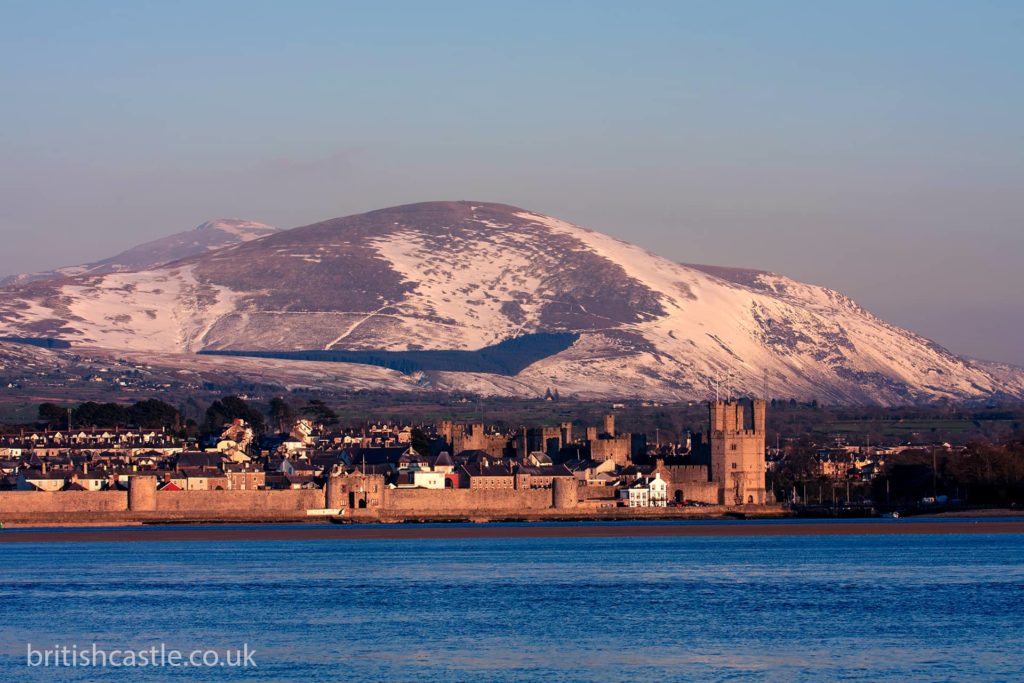
Situated on the banks of the River Seiont, Caernarfon was built on the bones of a former motte-and-bailey castle (typically wood, on a raised area of ground) that dated back to the late 11th century when Edward I decided to replace it with the current stone structure in 1283.
The Origins of Caernarfon Castle
Having led the successful Norman Conquest of England in 1066, William the Conqueror sought to claim North Wales which, at the time, was under the command of the Norman Robert of Rhuddlan. Upon Robert’s death, his cousin Hugh d’Avranches, Earl of Chester, reclaimed Norman control by building three castles: one at Aberlleiniog on Anglesey, one at an unknown location believed to be in Meirionnydd, and the third at Caernarfon.
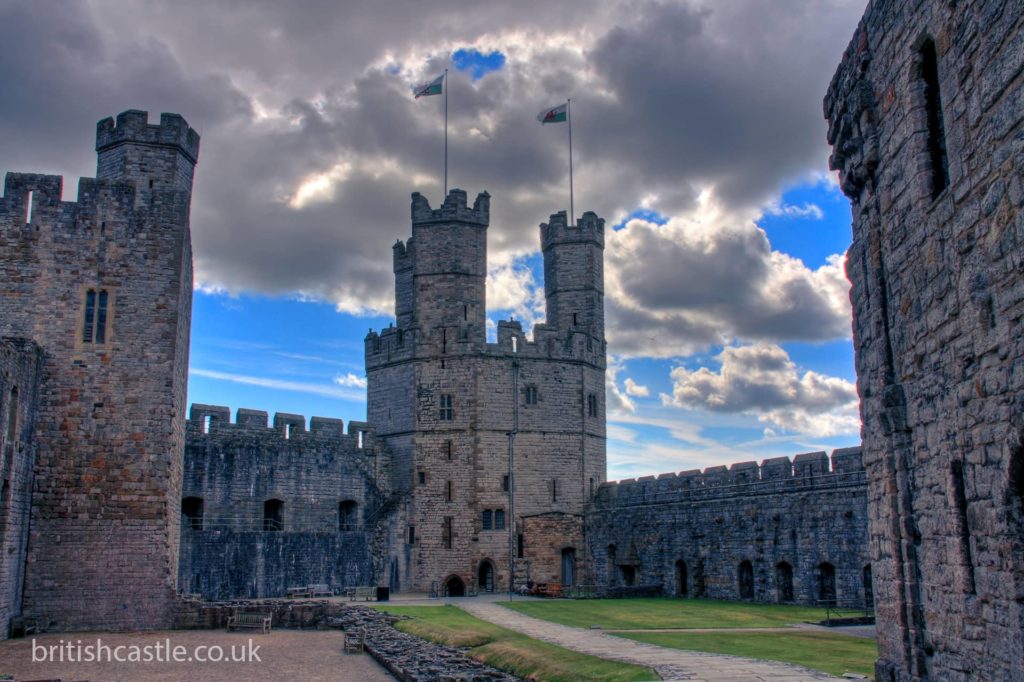
This earlier version of Caernarfon Castle came into possession of the Welsh princes following the recapture of Gwynedd in 1115, where it remained for more than a century––visitors of this expansive, motte-and-bailey structure included Llywelyn ap Gruffudd (also known as Llywelyn the Last, Prince of Wales from 1258 – 1282) and Llywelyn the Great (King of Gywnedd and eventual ruler of all of Wales). It’s at this period in history when Castle Caernarfon (or, as it was known at the time of Welsh ownership) begrudgingly changed hands for the first time.
Edward I’s invasion
In 1282, England’s King Edward I, working alongside royal architect James of St. George, led the brutal charge into Wales––with the support of a massive army of soldiers––pushing north from Carmarthen, eventually gaining control of the Conwy valley. Shortly after battling with the Welsh opposition, led by Dafydd ap Gruffudd (brother of Llywelyn ap Gruffudd), Edward I and his men captured castles and began building their own to establish an overwhelming rule, including sites at Harlech (Harlech Castle) and a new stone iteration of Castle Caernarfon.
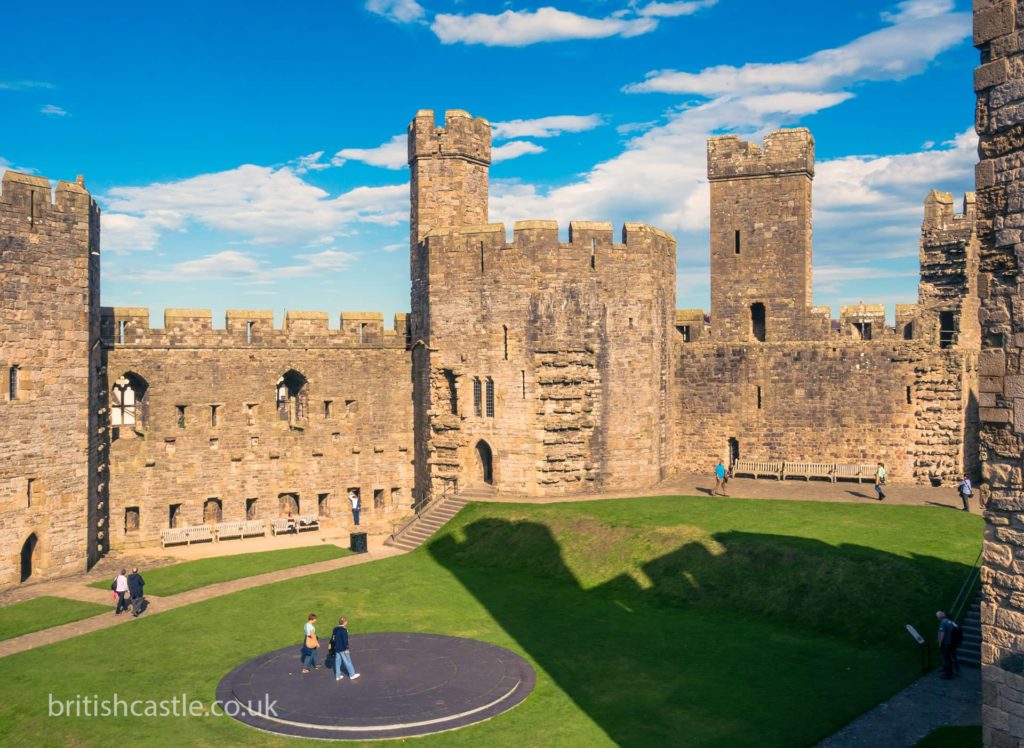
But it was not only the site at Caernarfon that the king and his master mason had in their sights. They also took advantage of the Welsh landscape and began to dot the northern area’s hills and valleys with multiple fortresses, creating reinforced towns like Beaumaris Castle and Conwy Town Walls, in which colonised English immigrants could settle.
Location
Castell Caernarfon (as it is referred to in Welsh) is situated between mainland North Wales and Anglesey (Ynys Mon), in Caernarfon, Gwynedd. Its strategically chosen location, at the southern end of the Menai Straits, allowed for sea access between the north and western Welsh coasts.
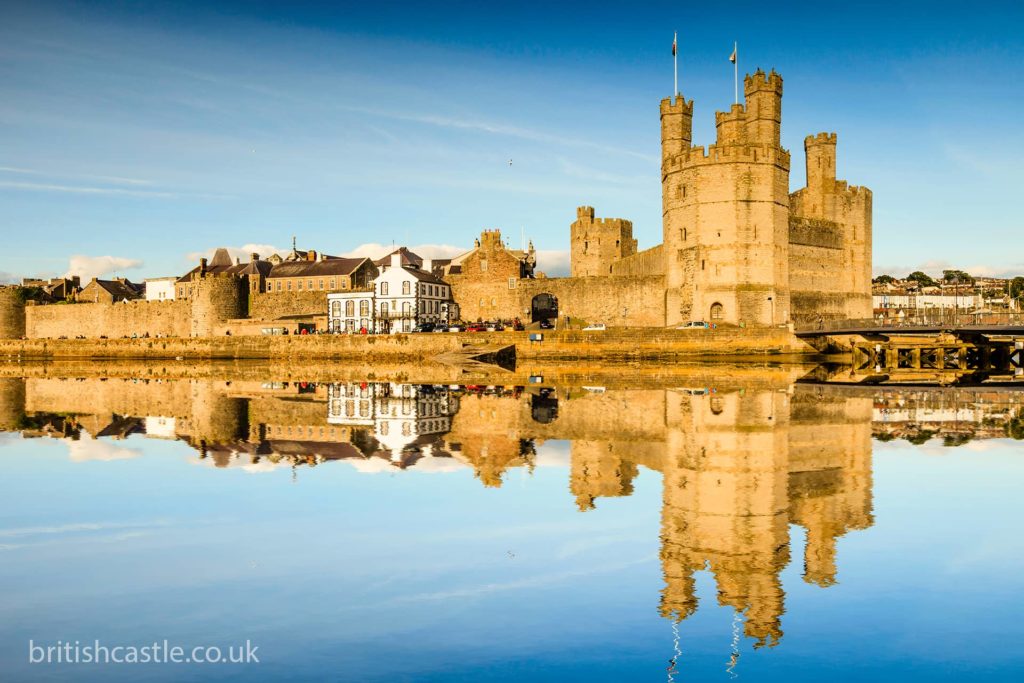
The site of this great castle wasn’t chosen by accident. It had previously been the location of a Norman motte and bailey castle and before that a Roman fort stood nearby. The lure of water and easy access to the sea made the banks of the River Seiont an ideal spot for Edward’s monster in masonry.
Many of Edward’s castles in Wales were similarly located near to water or along the coast, permitting travel between them and resupplying by water rather than overland (which was risky and vulnerable to interception and ambush by the Welsh).
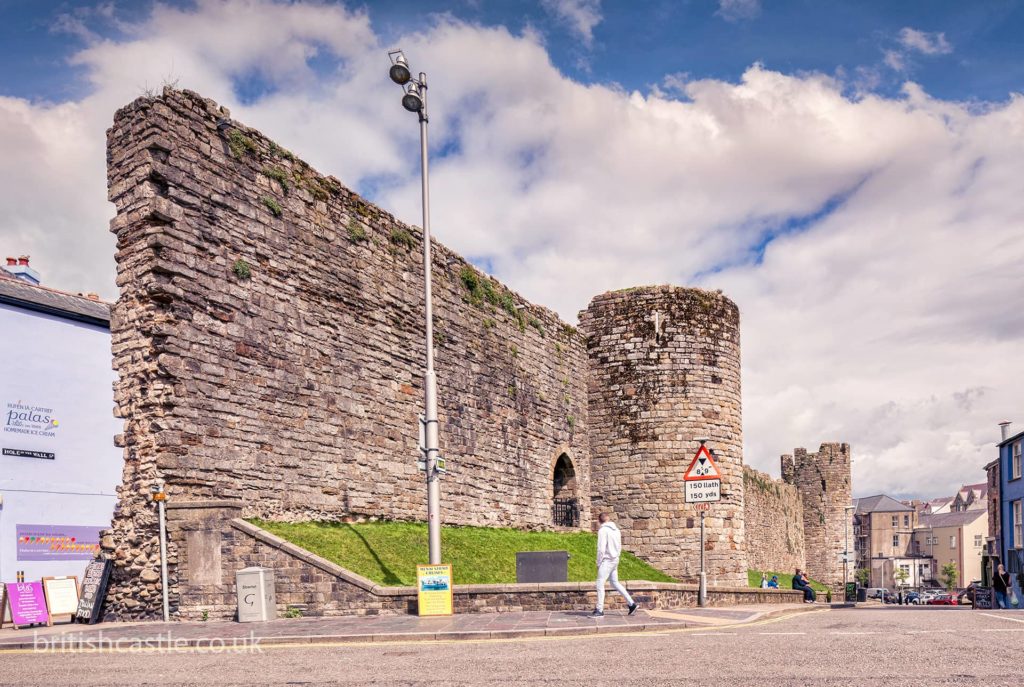
However, the castle and town walls were not only built here for strategic purposes. The location was a site of an existing Welsh settlement that was destroyed to make way for Caernarfon Castle and its town walls. A town that was to be populated entirely by English settlers once it was completed.
Who built Caernarfon Castle?
James of St George
Despite his affiliation with Edward’s kingdom, there is little known about the early life and times of Master James of St. George, other than the leftover castles and walls bearing his name. Considered to be one of the master architects of the European Middle Ages, his association with Conwy and Edward remains his most celebrated achievement.
The son of a master mason from Savoy, the cultural region in the Western Alps (today, the Savoy region is broadly divided by the French-Italian border), James of St. George learned the craft and became a respected designer in his own right. By 1270, he was responsible for the construction of many of the castles built at the behest of Philip I, Count of Savoy in the Viennois commune. This association with royalty is, assumedly, how he made the transition from mainland Europe to the court of Edward I––the earliest references in the English records of Master James of St. George date to 1278, where he is described as ‘going to Wales to put in order the works of the castles’.
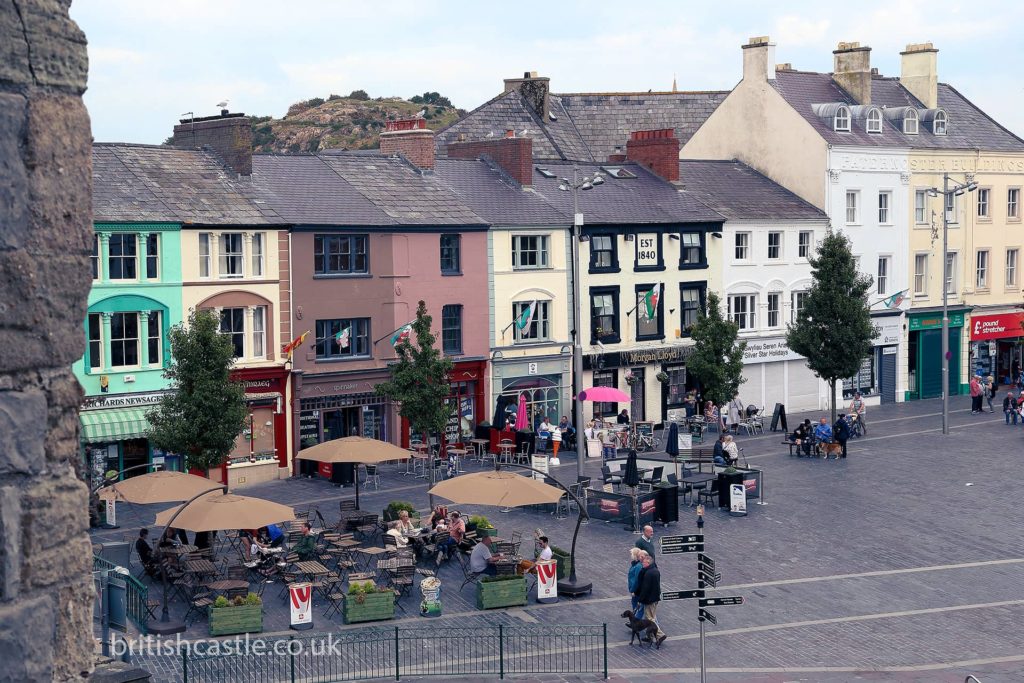
James of St. George was appointed Master of the Royal Works in Wales around 1285, giving him full control of the construction of all fortresses, including Caernarfon Castle. Noticeably, the design of all of these buildings shares a unique and mostly uniformed style––one that features a heavy, Savoy-Norman French influence. Flourishes aside, nearly all of the Welsh castles and the ring of town walls built by James of St. George have survived centuries of battle, age and weather, and remain today mostly intact.
Building timeline
The earliest reference to building at Caernarfon dates from June 24, 1283, at which point a ditch had been dug to separate the site of the castle from the town. Town walls were added to the new structure and a new quay was built to facilitate supplying the fortress.
In order to aid in the constructing of Caernarfon, hundreds of tradesmen and labourers would have travelled from far and wide to ply their skills (some as far as London), often carrying their own building equipment with them. According to historical documents, supplies and timber were shipped along the sea routes to Caernarfon’s aptly placed receiving docks from Liverpool, Anglesey and elsewhere in North Wales.
Despite its foreboding structure and intricate work, Caernarfon Castle was erected in lightning speed, essentially under five years––practically unheard of for a castle built by hand.
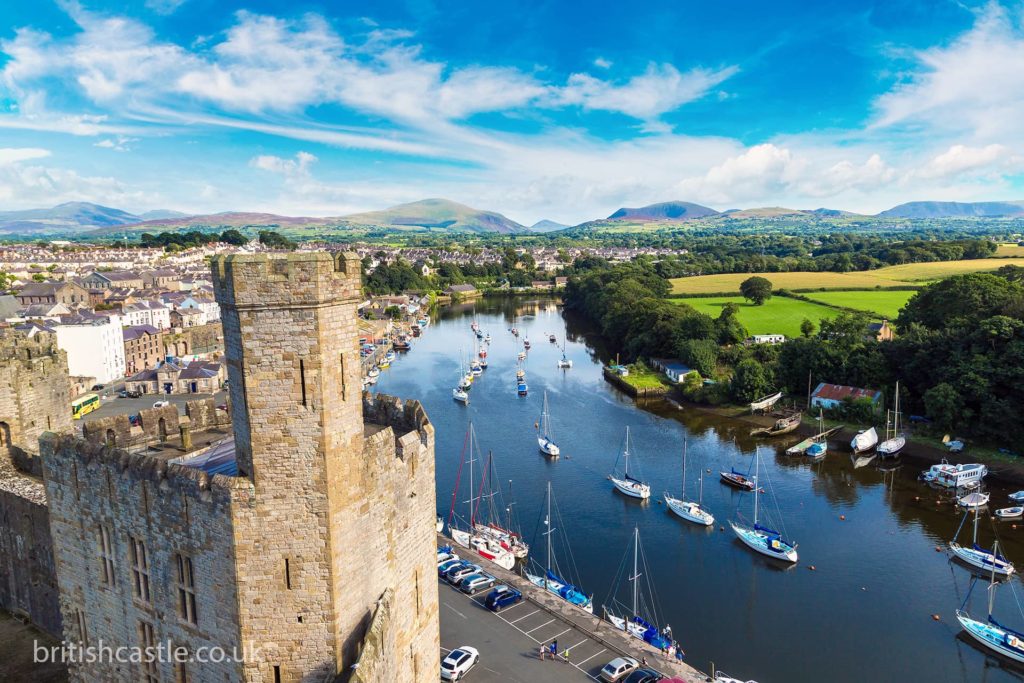
Caernarfon Castle by design
Caernarfon Castle’s Towers
Caernarfon castle is comprised of 4 main towers; Black Tower, Chamberlain Tower, Eagle Tower and Queen’s Tower. Unusual polygonal towers were the order of the day here, with the Eagle Tower being the most impressive of these. You will also note the colour-coded stones carefully arranged in bands. The fortress was incredibly grand by design: the ten-sided Eagle Tower alone measures more than 10m across at its base and would have had more than three floors and countless annexes throughout.
These were originally used as accommodation blocks. There were also two halls and two gateways with strong gatehouses.
The walls of the castle were up to 20 feet thick in places. The intention was for Caernarfon to be the Royal Palace in Wales and the home of the Prince of Wales, his family and attendants.
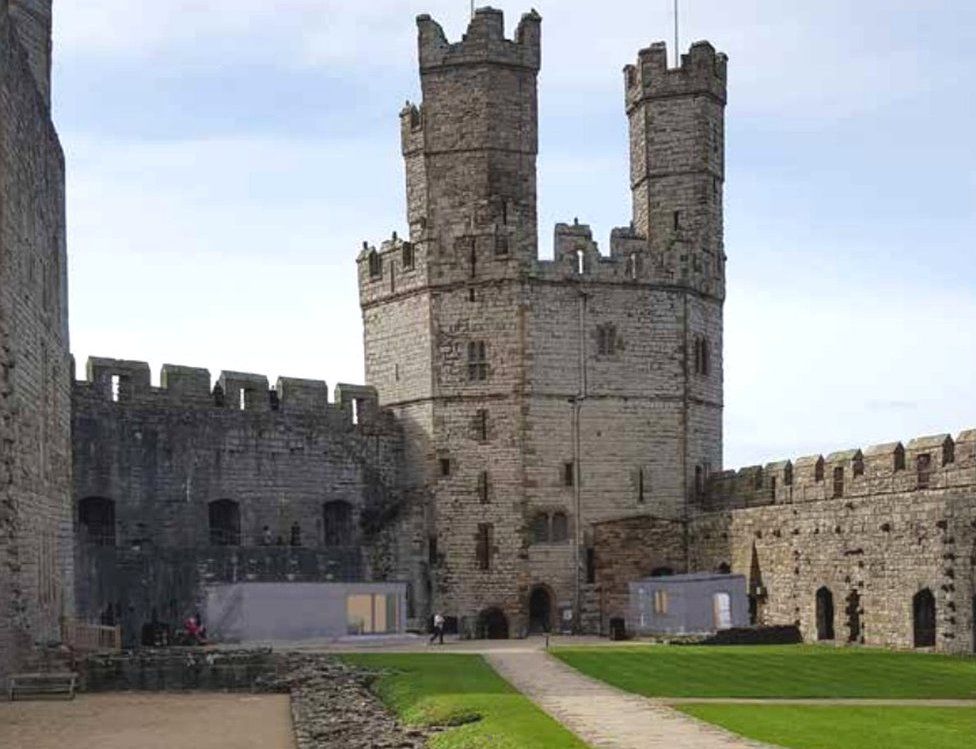
The town walls provided the main defence. They stretched for 800 yards and had 8 towers and 2 twin towered entrance points. The East Gate formed the main entrance whilst the West Gate overlooked the Menai Strait.
Subsequent additions and renovations to Caernarfon Castle within the later 12th and early 13th century were not major, and what remains of the existing fortress is considerably reminiscent of the Edwardian period. But despite the expenses––between £20,000 and £25,000 on both the castle and walls––much of what was planned for the castle was never carried out.
The two gateways; the King’s Gate and the Queen’s Gate were never fully built. However, even in an incomplete state they provided good defences for the castle, both being twin towered.
The King’s Gate, likely one of the most intimidating castle gatehouses in British history at the time, featured murder-holes from which scalding oil and water would have been dumped on attackers below. The Queen’s Gate, which looked seaward (to the King’s Gate’s town-facing façade), was the smaller of the two and was primarily used for unloading supplies and provisions from incoming ships.
Caernarfon’s Town Walls
The walls of Caernarfon were built at the same time as the castle. Like the main fortress, many labourers were mobilised from across England to help construct the defensive structures. Eventually, the town plan and walls were adapted to fit around the site of the former Norman castle, which lay just outside the new town, then being used a local market.
Work on the walls was swift, if not in uneven periods, as constantly evolving expansion plans meant that local houses and inns would be demolished to accommodate new swatches of fortifications. The initial cost of the town walls of Caernarfon Castle came to about £3,500––an enormous sum at the time.
Today, like the fortress itself, the walls remain standing in an unbroken 734m long circuit around the town, encompassing a parcel of land about 10.3 acres in size. The eight gap-backed towers along the wall originally included removable wooden bridges that would allow for sections of the walls to be blocked from intruders. Two entrances to and from the town sit at the East and West Gates.
Conflicts at Caernarfon Castle
Despite Caernarfon’s resilience and imposing size, not all were happy about the English-led invasion––and those dissenters let their anger be known.
The Welsh revolt of 1294, led by Madog ap Llewlyn, turned rebels throughout the country against the ruling English. Dissenters set out and destroyed many of the walls and fixtures of Caernarfon Castle––some even managed to breach the incredibly secure gatehouses and occupy the main building, before Edward I marched troops into Wales to quell the riots. By 1295, Edward’s men had recaptured Caernarfon, rebuilt many of the damaged walls and penalized the dissidents for the revolt.
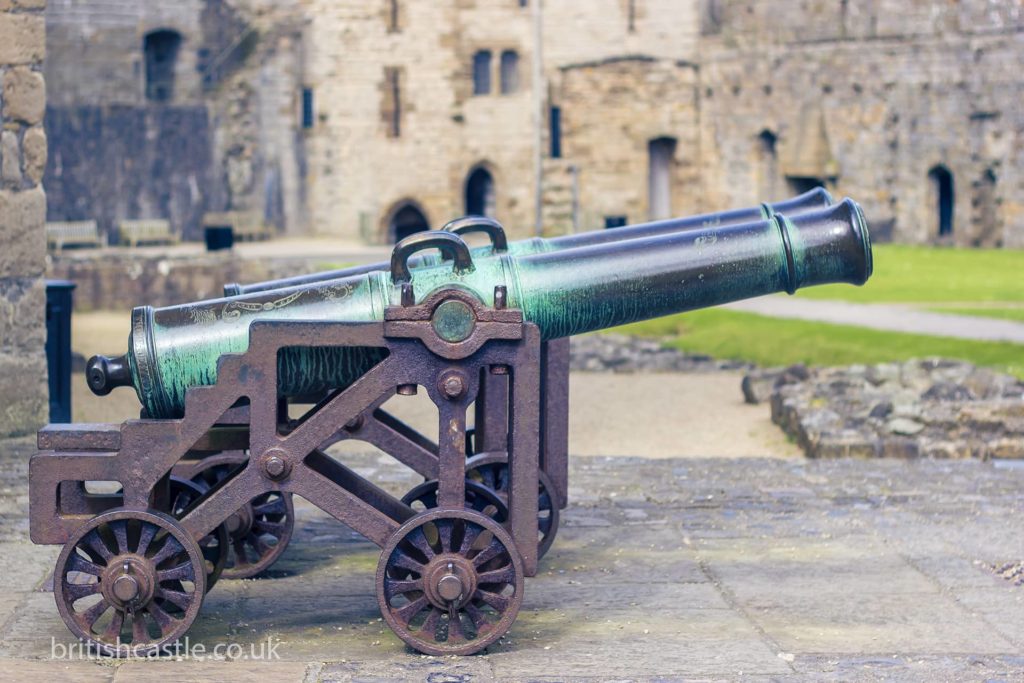
This, however, would not be the last besiegement Caernarfon would see. Just over a century after the Welsh revolt, Owain Glyn Dwr (a Welsh nationalist and descendant of the Princes of Powys) exacted his own vengeance against the Kingdom of England in 1401. Two years later, Owain’s supporters launched a deliberate attack on Caernarfon, storming the castle, this time with French support) in an ultimately unsuccessful attempt at capturing.
Like many of the Castles and Town Walls of King Edward I in Gwynedd, it wasn’t long until Caernarfon fell into disrepair, despite the rich pedigree of its inhabitants. By 1620, conditions were so poor––decayed materials, included rotted timber––that only the Eagle Tower and the incomplete King’s Gate had roofs. However, the building was in good enough standing, structurally, that it managed to survive being besieged three separate times during the English Civil War in the mid 17th century. Following a surrendering to Parliamentarian forces by the castle’s own constable, John Byron, in 1646, Caernarfon would never again see fighting.
Caernarfon Castle facts
· A brute of a fortress, Caernarfon Castle’s pumped-up appearance is unashamedly muscle-bound and intimidating. Picking a fight with this massive structure would have been a daunting prospect. By throwing his weight around in stone, King Edward I created what is surely one of the most impressive of Wales’s castles.
· Classed as King Edward I’s grandest castle it took almost 50 years to build at a cost of nearly £25,000. It is one of the best externally preserved fortresses in Britain.
· Along with his other castles in Gwynedd, Beaumaris, Harlech and Conwy, they have been deemed worthy of World Heritage status by UNESCO.
· According to architectural historian Arnold Taylor, “No building in Britain demonstrates more strikingly the immense strength of medieval fortifications than the great twin-towered gateway to Caernarfon Castle.”
· Today, Caernarfon Castle has become a keen tourist attraction, hosting around 200,000 annual visitors as well as featuring permanent museum exhibitions year-round. Held within the Queen’s Tower, the Museum of Welsh Fusiliers displays uniforms, medals, weaponry and memorabilia from throughout the 300-year heritage of this Welsh regiment. Meanwhile, the mighty Eagle Tower hosts an interactive history of Caernarfon Castle; and the Chamberlain Tower includes the throne and various ephemera and paraphernalia from the investiture ceremony of Prince Charles––the current Prince of Wales.
· In fact, Caernarfon Castle is the setting for all crowning ceremonies (where the monarch is given his formal title) for new Princes of Wales. Prince Charles, next in line for the Kingdom throne), received his title at Caernarfon in 1969, while his predecessor, Edward VIII was granted his in 1911 before famously abdicating the crown in 1936.
· Although Caernarfon Castle has been the property of the British Crown since it was built, it is currently owned and cared for by Cadw, the Welsh Government’s historic environment division, which is responsible for the maintenance and general upkeep of all of Wales’ historic buildings. Castle Caernarfon is also a World Heritage site. For opening times, admission fees and other information please visit their Caernarfon Castle pages.
Or visit our home page to find out about more castles in Britain.